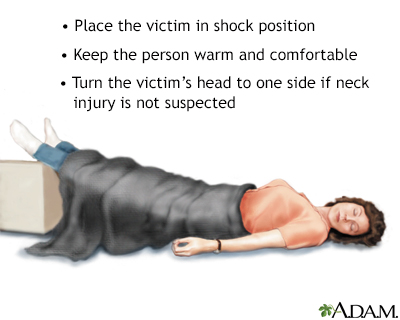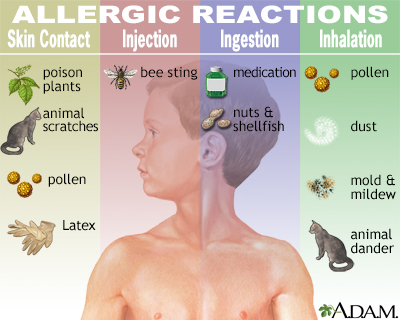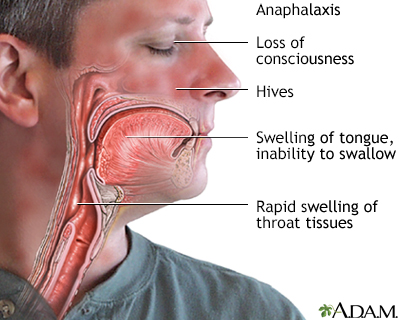Anaphylaxis
Anaphylaxis is a life-threatening type of allergic reaction.
Allergic reaction
Allergic reactions are sensitivities to substances called allergens that come into contact with the skin, nose, eyes, respiratory tract, and gastroin...

Causes
Anaphylaxis is a severe, whole-body allergic reaction to a chemical that has become an allergen. An allergen is a substance that, for most people, is harmless, but in some people, it can cause an allergic reaction.
Allergen
An allergen is a substance that can cause an allergic reaction. In some people, the immune system recognizes allergens as foreign or dangerous. As ...

After being exposed to a substance such as bee sting venom, the person's immune system becomes sensitized to it. When the person is exposed to that allergen again, an allergic reaction may occur. Anaphylaxis usually happens quickly after the exposure. The condition is severe and involves the whole body.
Tissues in different parts of the body release histamine and other substances. This causes the airways to tighten and leads to other symptoms.
Some medicines (morphine, x-ray dye, aspirin, and others) may cause an anaphylactic-like reaction (often called an anaphylactoid reaction) when people are first exposed to them. These reactions are not the same as the immune system response that occurs with true anaphylaxis. But, the symptoms, risk of complications, and treatment are the same for both types of reactions.
Anaphylaxis can occur in response to any allergen. Common causes include:
- Medicine allergies
Medicine allergies
Drug allergies are a group of symptoms caused by an allergic reaction to a drug (medicine).
 ImageRead Article Now Book Mark Article
ImageRead Article Now Book Mark Article - Food allergies
Food allergies
A food allergy is a type of immune response triggered by eggs, peanuts, milk, shellfish or some other specific food.
 ImageRead Article Now Book Mark Article
ImageRead Article Now Book Mark Article - Insect bites/stings
Insect bites/stings
Insect bites and stings can cause an immediate skin reaction. The bite from fire ants and the sting from bees, wasps, and hornets are most often pai...
 ImageRead Article Now Book Mark Article
ImageRead Article Now Book Mark Article
Pollen and other inhaled allergens rarely cause anaphylaxis. Some people have an anaphylactic reaction with no known cause.
Anaphylaxis is life threatening and can occur at any time. Risks include a history of any type of allergic reaction.
Symptoms
Symptoms develop quickly, often within seconds or minutes. They may include any of the following:
- Abdominal pain
- Feeling anxious
- Chest discomfort or tightness
- Diarrhea
- Difficulty breathing, coughing, wheezing, or high-pitched breathing sounds
- Difficulty swallowing
- Dizziness or lightheadedness
Dizziness
Dizziness is a term that is often used to describe 2 different symptoms: lightheadedness and vertigo. Lightheadedness is a feeling that you might fai...
 ImageRead Article Now Book Mark Article
ImageRead Article Now Book Mark ArticleLightheadedness
Fainting is a brief loss of consciousness due to a drop in blood flow to the brain. The episode most often lasts less than a couple of minutes and y...
Read Article Now Book Mark Article - Hives, itchiness, redness of the skin
Hives
Hives are raised, often itchy, red bumps (welts) on the surface of the skin. They can be an allergic reaction to food or medicine. They can also ap...
 ImageRead Article Now Book Mark Article
ImageRead Article Now Book Mark Article - Nasal congestion
- Nausea or vomiting
- Palpitations
Palpitations
Palpitations are feelings or sensations that your heart is pounding or racing. They can be felt in your chest, throat, or neck. You may:Have an unpl...
 ImageRead Article Now Book Mark Article
ImageRead Article Now Book Mark Article - Slurred speech
- Swelling of the face, eyes, or tongue
- Unconsciousness
Exams and Tests
The health care provider will examine the person and ask about what might have caused the condition.
Tests for the allergen that caused anaphylaxis (if the cause is not obvious) may be done after treatment.
Treatment
Anaphylaxis is an emergency condition that needs medical attention right away. Call 911 or the local emergency number immediately.
Check the person's airway, breathing, and circulation, which are known as the ABC's of Basic Life Support. A warning sign of dangerous throat swelling is a very hoarse or whispered voice, or coarse sounds when the person is breathing in air. If necessary, begin rescue breathing and CPR.
CPR
CPR stands for cardiopulmonary resuscitation. It is an emergency life-saving procedure that is done when someone's breathing or heartbeat has stoppe...
Read Article Now Book Mark Article- Call 911 or the local emergency number.
- Calm and reassure the person.
- If the allergic reaction is from a bee sting, scrape the stinger off the skin with something firm (such as a fingernail or plastic credit card). Do not use tweezers. Squeezing the stinger will release more venom.
- If the person has emergency allergy medicine on hand, help them take or inject it. Do not give medicine by the mouth if the person is having difficulty breathing. An epinephrine injector should be used immediately if it is available.
- Take steps to prevent shock. Have the person lie flat, raise the person's feet about 12 inches (30 centimeters), and cover the person with a coat or blanket. Do not place the person in this position if a head, neck, back, or leg injury is suspected, or if it causes discomfort.
Shock
Shock is a life-threatening condition that occurs when the body is not getting enough blood flow. Lack of blood flow means the cells and organs do n...
 ImageRead Article Now Book Mark Article
ImageRead Article Now Book Mark Article
DO NOT:
- Do not assume that any allergy shots the person has already received will provide complete protection.
- Do not place a pillow under the person's head if they are having trouble breathing. This can block the airways.
- Do not give the person anything by mouth if they are having trouble breathing.
Paramedics or other providers may place a tube through the nose or mouth into the airways. Or emergency surgery will be done to place a tube directly into the trachea.
Place a tube through the nose or mouth
Endotracheal intubation is a medical procedure in which a tube is placed into the windpipe (trachea) through the mouth or nose. In most emergency si...

Place a tube directly into the trachea
A tracheostomy is a surgical procedure to create an opening through the neck into the trachea (windpipe). A tube is most often placed through this o...

The person may receive medicines to further reduce symptoms.
Outlook (Prognosis)
Anaphylaxis can be life threatening without prompt treatment. Symptoms usually do get better with the right therapy, so it is important to act right away.
Possible Complications
Without prompt treatment, anaphylaxis may result in:
- Blocked airway
- Cardiac arrest (no effective heartbeat)
Cardiac arrest
Cardiac arrest occurs when the heart suddenly stops beating. When this happens, blood flow to the brain and the rest of the body also stops. Cardia...
Read Article Now Book Mark Article - Respiratory arrest (no breathing)
Respiratory arrest
Breathing that stops from any cause is called apnea. Slowed breathing is called bradypnea. Labored or difficult breathing is known as dyspnea....
Read Article Now Book Mark Article - Shock
- Death
When to Contact a Medical Professional
Call 911 or the local emergency number if you or someone you know develops severe symptoms of anaphylaxis. Or, go to the nearest emergency room.
Prevention
To prevent allergic reactions and anaphylaxis:
- Avoid triggers such as foods and medicines that have caused an allergic reaction in the past. Ask detailed questions about ingredients when you are eating away from home. Also carefully examine ingredient labels.
- If you have a child who is allergic to certain foods, introduce one new food at a time in small amounts so you can recognize an allergic reaction.
- People who know that they have had serious allergic reactions should wear a medical ID tag or bracelet.
- If you have a history of serious allergic reactions, carry injectable epinephrine according to your provider's instructions.
- There is no contraindication to using epinephrine in a severe allergic reaction.
Reviewed By
Deborah Pedersen, MD, MS, Allergy & Asthma Care, PC, Taunton, MA. Review provided by VeriMed Healthcare Network. Also reviewed by David C. Dugdale, MD, Medical Director, Brenda Conaway, Editorial Director, and the A.D.A.M. Editorial team.
Barksdale AN, Ross W. Allergy, anaphylaxis, and angioedema. In: Walls RM, ed. Rosen's Emergency Medicine: Concepts and Clinical Practice. 10th ed. Philadelphia, PA: Elsevier; 2023:chap 106.
Dreskin SC, Stitt JM. Anaphylaxis. In: Burks AW, Holgate ST, O'Hehir RE, et al, eds. Middleton's Allergy: Principles and Practice. 9th ed. Philadelphia, PA: Elsevier; 2020:chap 75.
Schwartz LB, Castells M. Anaphylaxis. In: Goldman L, Cooney KA, eds. Goldman-Cecil Medicine. 27th ed. Philadelphia, PA: Elsevier; 2024:chap 233.
Shaker MS, Wallace DV, Golden DBK, et al. Anaphylaxis-a 2020 practice parameter update, systematic review, and Grading of Recommendations, Assessment, Development and Evaluation (GRADE) analysis. J Allergy Clin Immunol. 2020;145(4):1082-1123. PMID: 32001253 pubmed.ncbi.nlm.nih.gov/32001253/.








 All rights reserved.
All rights reserved.